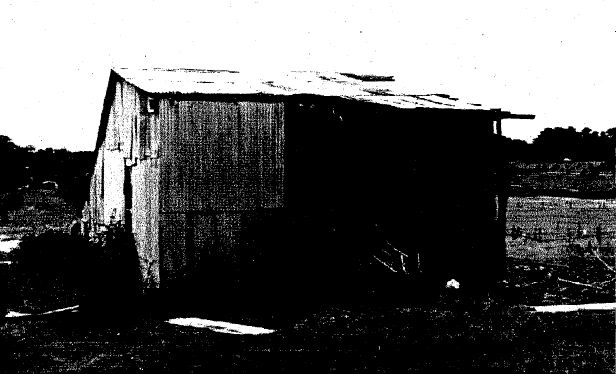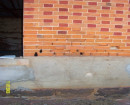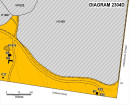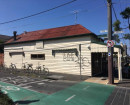FORMER GOLDEN KING GOLD MINE BATTERY
Yan Yean Road (off) North Oatlands Road YARRAMBAT, NILLUMBIK SHIRE
-
Add to tour
You must log in to do that.
-
Share
-
Shortlist place
You must log in to do that.
- Download report


Statement of Significance
REVISED STATEMENT OF SIGNIFICANCE, CONTEXT, 2010
What is significant?
The c1950 Golden King gold mine battery including: the ore crushing plant, the timber framed corrugated shed, the golden king shaft and associated machinery.
How is it significant?
The Golden King gold mine battery is historically, technically and archaeologically significant to the Shire of Nillumbik.
Why is it significant?
The Golden King gold mine battery is historically significant for its association with the gold mining history of the Yarrambat district and as a rare (or the only) working example of a well preserved traditional ore crushing plant, in situ, within the Melbourne Metropolitan area (Criteria A & B). The golden king gold mine battery is historically and technically significant as a rare example of an intact four head battery and is the only known surviving example of a battery produced by A Robinson's Soho foundry at Maryborough (Criteria B & D). The golden king gold mine battery is archaeologically significant for the shaft's potential to yield information about the gold mining history of the Yarrambat district (Criterion C).
MOLONEY, FORMER GOLDENCROWN BATTERY STUDY, 2000
The former Golden King battery plant is of regional heritage significance. It was erected at the North Oatlands Road Golden King mine site in 1941, having been removed, complete with battery shed, from an as yet unknown mine at Spargo Creek in central Victoria, and removed to the Yarrambat Heritage Museum, Yan Yean Road Yarrambat, where the mine was closed down.
The battery is of regional technical significance as: - a rare example of an intact four head battery in Victoria; for its association with A Robinson's Soho Foundry at Maryborough, and as the only known surviving example of a battery produced by this engineering firm; as the only gold battery surviving in the Melbourne district; as one of relatively few intact and operational batteries surviving in Victoria; and, most likely, as an example of a light early twentieth century prospecting battery; for its association with the important and innovative Australian engineering company, AH McDonald & Co, by means of the 30 horsepower diesel engine which powers the plant; as the only known example of a McDonald engine operating a gold battery in Victoria; and as a rare surviving example of a reasonably intact early twentieth century battery plant and shed.
The battery is of local historical significance as a surviving remnant of mining in Yarrambat, and in particular of quartz mining, which was undertaken in the district on a relatively small scale from the late nineteenth to the late twentieth century; for its association with the locally important Clayton mining family; and for its association with an earlier mining venture believed to be at Spargo Creek, between Ballan and Daylesford. The battery is of local social significance to Yarrambat, where mining has been an important part of the fabric of community life from the 1930s. The initiative of the Yarrambat community in acquiring and reconstructing the plant is expressive of this significance.
-
-
FORMER GOLDEN KING GOLD MINE BATTERY - Physical Description 1
THE BATTERY: DESCRIPTION, AND INTERGRITY
Description
The place consists of a battery and battery shed from the Golden King mine, North Oatlands Road Yarrambat, in the course of reconstruction in the Yarrambat Heritage Museum, Yan Yean Road Yarrambat. Both the battery and the shed are said to have been used at Spargo Creek prior to being reassembled for use at the Golden King mine in1941. The reconstruction is substantially advanced. The battery shed is nearly complete, and the battery erected, awaiting the placement of the stampers and the assembly of belt drives. .
Battery
The four-stamper battery bears a plaque with the manufacturer's name: "A. Robinson, Soho Foundry, Maryborough". No product number or other information was observed. It is of iron construction except for the frame, which comprises substantial squared timbers incorporating original iron bracing. It has an intact timber table, to which the battery's original amalgamating plates will be fitted.
The battery is mounted on new concrete foundations. To ensure stability and safety when the battery operates, two damaged timber uprights in the battery have been replaced with anew light steel frame. The original block and tackle, used to facilitate maintenance of the stampers, is in place on this frame. The camshaft does. not extend beyond the battery frame, indicating that the battery was never formerly larger, or made to accommodate a possible increase in the number of stampers.
Power Plant
The power plant is an "Imperial Super Diesel, crude oil engine" (30 HP T Type), Senal No. 815T, manufactured in 1941by AH McDonald & Co Pty Ltd, 'Imperial' Engine Works, 566-574 Bridge Road Richmond. l This 30 horsepower McDonald diesel engine is from the Golden King mine. It has been made operational, and will power the plant for occasional displays.
The reconstructed power plant has been altered from its configuration during the final working years of the mine. After the connection of Yarrambat to electricity in 1954 an electric engine powered the battery. The reassembled plant will be powered by the McDonald diesel engine which is thought to be the same engine that was the original source of power for the battery.2 The McDonald engine then operated the air compressor, until 'the closure of the mine. The large electric engine that operated the battery since 1954 remains in storage, but is not serviceable.
Battery Shed
The battery shed has been rebuilt according to its original design, with original fabric as far as possible. New comer posts have been used, and some new corrugated iron cladding, but most of the timber frame and iron sheeting is from the Golden King shed.
The battery is positioned with its amalgamating tables facing and very near to the power plant. The ore hoppers are loaded from the open end of the shed. This is in accordance with the well-documented original layout of the plant.
Other Equipment
The Yarrambat Heritage Museum has acquired the majority of the Golden King mining plant. Most of it is stored in the Young farm machinery shed. It is extensive, and has been collected with a view to authentic re-assembly. It includes, for example:
Four electric motors: one large, for driving battery (General Electric Co, Birmingham), and three others for other machinery (The Electrical Power Engineering Co, Birmingham);
- Electric switchboard;
- Compressor (The Consolidated Pneumatic Tool Co. Ltd. Australia);
- Winch (MacRobertson, Engineer, I ton);
- Large side runs for belt drive assemblies;
- A wooden windlass; ,
- Amalgamating plates, gold pots;
- Hoses, air blowers, plumbing, hardware (bolts etc), even including pickheads.
Some items, such as a jackhammer, were unable to be obtained by the Heritage Museum. A length of tramlines and an associated troney were also unable to be retrieved from the underground workings before the shafts were capped. The timber frame of the other four head battery (without the stamper mechanism) was not aql1ired by the Museum.
The Heritage Museum intends to set up the compressor to operate a jackhammer. Presumably this will entail use of the currently disused pulley shafts and belts. The mine's original timber poppet heads were removed and replaced with the metal one that is now prominently located opposite the fonner mine, at the Yarrambat school. The Heritage Museum plans to rebuild the original timber poppet head, of which there are photographs, and reassemble its original wheel and winch.
It is presumed that other components of the mine plant, such as the electric .engines, which cannot be reassembled, will eventually form part of an interpretative display. Most of these items are currently protected from the weather.
Importantly, the Yarrambat Heritage Museum has a good record of the battery and mine in its operating state. This will guide restoration; ensure authenticity, and assist interpretation. This includes a series of photographs of the layout of the plant prior to its disassembly and removal, and a plan of the dimensions of the original shed. The Museum also has an inventory of the equipment removed from the mine, and a video of the underground workings, made when the mine was in operation.
FORMER GOLDEN KING GOLD MINE BATTERY - Integrity
Integrity and Condition
The condition of the site appears good. Mechanical parts are being overhauled prior to reassembly, with a view to making the plant operational for occasional displays .
The new steel frame inserted within the battery diminishes its integrity, but is light and not too intrusive, and (at present) clearly a modem addition. If a good match with the original timbers is possible, it would be better to use this, on the heritage principle of replacing 'like with like'. This might remain an option for the future.
The concrete foundation and steel frame are, at present, very obviously modern additions, but with age they may appear less distinct from the original features. It would be advisable (when the project is running) for visitor information to be provided which enables an appreciation of what is original and what was altered at the time of relocating the battery. It is essential that all such changes be properly documented by the Yarrambat Heritage Museum as part of the reconstruction process. This would include changes to the layout of the plant, the new timbers, corrugated iron cladding, and any other changes to the battery shed.
The removal of the battery from its original site diminishes its significance substantially. Alterations to the fabric itself, such as those described above, also diminish the heritage significance of the structure to some extent. In general however, considerable care seems have been taken to ensure as much authenticity of the battery plant as possible, and with proper documentation of changes, and interpretation to visitors, the integrity of the structure itself will be substantially preserved.
It needs to be carefully considered however as to whether continuing to remove local heritage structures to the Heritage Museum site will confuse messages to the public, both about the site, and about heritage. Similarly, recreation of prominent mining structures, such. as poppet head, may be appropriate, but also has the potential to confuse, for example, about the location of mining in the district, and about what is and what is not authentic on the site. A collection policy, conservation policy, and site management plan would assist in the appropriate long-term development of the Museum.
FORMER GOLDEN KING GOLD MINE BATTERY - Historical Australian Themes
3.3.3 Prospecting for precious metals
3.4 Utilising natural resources
3.4.3 MiningHeritage Study and Grading
Nillumbik - Nillumbik Shire Heritage Study
Author: Graeme Butler & Assoc
Year: 1997
Grading: LocalNillumbik - Nillumbik Heritage Investigation: Fmr Golden King Battery
Author: David Moloney, HTM History Services St Kilda
Year: 2000
Grading: Local
-
-
-
-
-
SMUGGLERS GULLY
 Victorian Heritage Inventory
Victorian Heritage Inventory -
FORMER GOLDEN KING GOLD MINE BATTERY
 Nillumbik Shire
Nillumbik Shire
-
-








